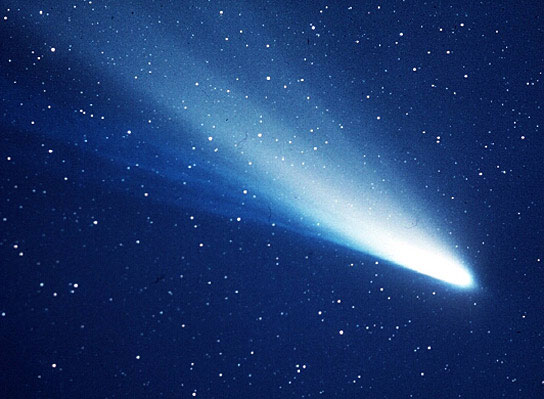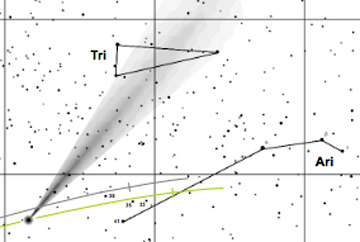|

Astronomy
historians recently published a new analysis of ancient Chinese and
Syrian manuscripts that document sightings of Halley’s comet in the year
760 AD.
Their
research was motivated by a seemingly unrelated mystery — anomalous
variations in radiocarbon dating for relics from the late 8th Century.
C-14
is an unstable isotope of carbon (its nucleus has 8 neutrons instead of
the usual 6 in C-12) that decays with a half-life of 5730 years. Cosmic
rays continually produce C-14 in our upper atmosphere. Decay and
production rates reach a balance at about 1 C-14 per trillion C-12 in
Earth’s biosphere. All life ingests this carbon mixture. When an
organism dies, its C-14 is no longer replenished, and its amount is
halved every 5730 years. Measuring the remaining level of C-14 in
organic remains determines when it died.
As
in nearly every scientific measurement, reality is a bit more complex.
While C-14 decay is precisely predictable, its abundance varies slightly
depending on solar activity, cosmic ray flux, volcanic eruptions,
industrial carbon emissions, and other factors.
Since
radiocarbon dating is important in understanding our history, great
efforts are made to quantify variations in the C-14 to C-12 ratio. One
particular anomaly is an apparent ratio change in the late 8th Century.
The
authors thought this might be due to a comet striking Earth and adding
C-12 to our biosphere. This prompted them to search historical texts for
clues. They found no record supporting a close comet encounter, so the
C-14 dating anomaly remains a mystery.
They
did, however, serendipitously find new evidence of a distant comet
passing in 760 AD that they can now identify as 1P/Halley. (“1P” denotes
the first identified periodic celestial body, which Edmund Halley
discovered in 1705.)
This new evidence records the comet's sky position on a certain day and time, and is documented in the Syriac Chronicle of Zuqnin of 776 AD, most of which was preserved over so many centuries in the Vatican Library.
While
astronomers can precisely predict the motions of stars, planets, and
most asteroids, comet motion is much less predictable.
The
factors complicating comet motion include: their highly eccentric
orbits; long orbital periods; and deflections from outgassing and close
planetary approaches.
In
the deep freeze of the remote solar system, comets accumulate volatiles
(low-mass molecules) that evaporate as the comet nears the Sun. This
“outgassing” forms their iconic tails, but can significantly alter their
trajectories.
Prior
studies showed Halley’s comet passed close to Earth in 837 AD, only
about 13 times farther than the Moon, which substantially changed its
trajectory. Uncertainties accumulating over centuries of pre-telescopic
observations made it impossible to precisely quantify that change,
thereby precluding accurate calculations of its prior motion.
The
760 AD Syrian sighting reduced those orbital uncertainties, allowing
astronomers to associate Halley’s comet with previously unidentified
comet sightings as far back as two centuries BC.
Properly
interpreting ancient texts is challenging. Languages change over the
centuries, as do calendars and the names societies assign stars and star
groupings. Additionally, we rarely know the techniques and
precision with which each ancient sighting was made.
By
successfully addressing all these challenges, astronomers reconstructed
the last 29 visitations of Halley’s comet, dating back 2219 years. They
find its orbital period varies from 74 to 79 years.
The
authors of this paper are D.L. Neuhäuser, R. Neuhäuser, M. Mugrauer, A
Harrak, and J. Chapman are from Italy, Germany, Germany, Canada and the
U.S., respectively. They also recovered this Chinese drawing of a
sighting of Halley’s comet in 760 AD. The head of the comet symbol
denotes its sky position, while its tail points away from the Sun. The
stick figures denote asterisms (constellations) of classical Chinese
astronomy.

This story has two surprising and encouraging twists.
Firstly,
the search for a radiocarbon dating anomaly failed, but serendipitously
discovered the ancient orbital history of astronomy’s most famous
comet.
Secondly, two seemingly unrelated specialties — astronomy and history — combined to advance both.
Best Wishes,
Robert

October 2021
Note: Previous newsletters can be found on my website.
|